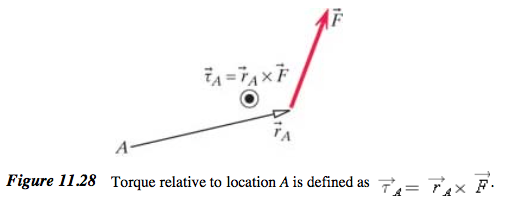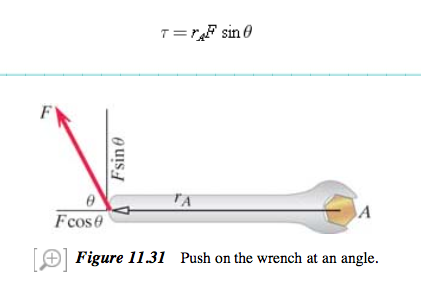The Angular Momentum Principle: Difference between revisions
| Line 11: | Line 11: | ||
Total angular momentum is equal to the sum of translational angular momentum about location A and rotational angular momentum about the object's center of mass. In multi-particle systems, the translational angular momentum is equal to the vector product of the distance of the center of mass to location A and total momentum of the whole system. Rotational angular momentum is equal to the vector product of the distance of particle 1 to center of mass and momentum of particle 1 plus the vector product of distance of particle 2 to center of mass and momentum of particle 2 plus all the particles in the system. If total angular momentum and translational angular momentum are known then rotational angular momentum can be found just by subtracting Ltrans from Ltot and if Ltot and Lrot are known, Ltrans can be found by subtracting Lrot from Ltot. | Total angular momentum is equal to the sum of translational angular momentum about location A and rotational angular momentum about the object's center of mass. In multi-particle systems, the translational angular momentum is equal to the vector product of the distance of the center of mass to location A and total momentum of the whole system. Rotational angular momentum is equal to the vector product of the distance of particle 1 to center of mass and momentum of particle 1 plus the vector product of distance of particle 2 to center of mass and momentum of particle 2 plus all the particles in the system. If total angular momentum and translational angular momentum are known then rotational angular momentum can be found just by subtracting Ltrans from Ltot and if Ltot and Lrot are known, Ltrans can be found by subtracting Lrot from Ltot. | ||
[[File:conservationofmomentum.png]] | |||
[[File:am4.png]] | [[File:am4.png]] | ||
[[File:am3.png]] | [[File:am3.png]] | ||
[[File:torque1.png]] | |||
[[File:am5.png]] | [[File:am5.png]] | ||
[[File:amprinciple.png]] | [[File:amprinciple.png]] | ||
== A Computational Model == | == A Computational Model == | ||
Revision as of 19:10, 30 November 2015
claimed by rhollman6
The Main Idea
The angular momentum of an object is the product of the moment of inertia and the angular velocity and is a vector quantity. Total angular momentum is equal to the translational angular momentum about a location A plus the rotational angular momentum around the object's center of mass. The angular momentum principle says that derivative of total angular momentum is equal to the torque applied to the object. Torque is equal to the force about a particular location A times the vector from location A to point of application of force (this is a vector product and torque is a vector quantity). Applying a torque to the system changes the angular momentum of the system. The change in angular momentum of a particle relative to location A is equal to the net angular impulse (net torque,A times the change in time). The angular momentum principle is similar to the momentum principle and the angular momentum principle can be used to calculate torque. Angular momentum is conserved so if system gains angular momentum, the surroundings lose that amount. If there is no torque (and therefore no force) applied to the system then the angular impulse is zero and initial angular momentum equals final angular momentum. The angular momentum principle allows you to learn information about initial angular momentum, final angular momentum, change in time and/or torque depending on what variables are known.
A Mathematical Model
Translational angular momentum is equal to the vector cross product of the location from the object pointing to the location A and the momentum of the object. It can also be found by multiplying the magnitude of the distance vector times the magnitude of the momentum vector times the sin of theta (the angle the two vectors make when they are put tail to tail).
Total angular momentum is equal to the sum of translational angular momentum about location A and rotational angular momentum about the object's center of mass. In multi-particle systems, the translational angular momentum is equal to the vector product of the distance of the center of mass to location A and total momentum of the whole system. Rotational angular momentum is equal to the vector product of the distance of particle 1 to center of mass and momentum of particle 1 plus the vector product of distance of particle 2 to center of mass and momentum of particle 2 plus all the particles in the system. If total angular momentum and translational angular momentum are known then rotational angular momentum can be found just by subtracting Ltrans from Ltot and if Ltot and Lrot are known, Ltrans can be found by subtracting Lrot from Ltot.
A Computational Model
How do we visualize or predict using this topic. Consider embedding some vpython code here Teach hands-on with GlowScript
Examples
Be sure to show all steps in your solution and include diagrams whenever possible
Simple[edit] Middling[edit] Difficult[edit]
Connectedness
How is this topic connected to something that you are interested in? How is it connected to your major? Is there an interesting industrial application?
History
Put this idea in historical context. Give the reader the Who, What, When, Where, and Why.
See also
Are there related topics or categories in this wiki resource for the curious reader to explore? How does this topic fit into that context?
Further reading
Books, Articles or other print media on this topic
External links
Internet resources on this topic
References
This section contains the the references you used while writing this page






